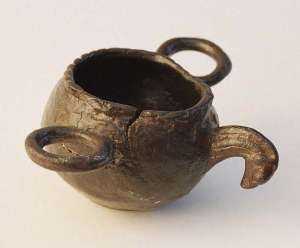
|
RITUAL POT
Bronze. Height 6,5; the diameter of mouth 6,6. Body is globular, wall massive. The mouth of pot is designed in the form of twisted relief rope. In the upper part of the body, two ring-knobs are horizontally diametrically located. At the same level, between these knobs, protrusion - sham spout in the appearance of the steeply bent horse neck (?), which is ended with the head of predatory bird (like talon of eagle, like a horse, griffin). The head of predatory bird has strongly bent beak. Along the neck - smooth crest, two smooth lines are engraved below. It is completely analogous with - pot from the museum of Eshmola, found in Imite - The Valley Ishkuman (Gilgit) - see: Stein 1944; Yettmar 1979. The pot of cast, helve ring and bill are cast separately. Eastern Pamirs. Tomb of Alichur II, tumulus III. 4C - 3C BC. „L„y„„.: „L„y„„„r„y„~„ƒ„{„y„z 1972, „ƒ. 44, 47 - 48, „†„€„„„€ 14, „„„p„q„|. 11; „_„S ‡‚ 16.
|
thumbnail size : 300x248 (6,693 bytes)
|